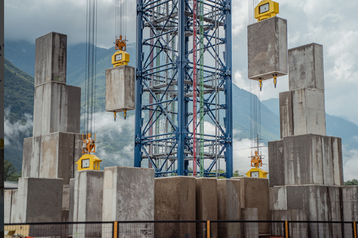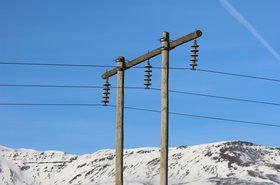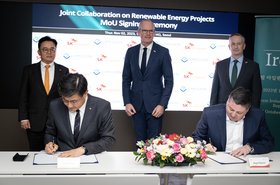Energy Vault has found South African partners for its idea of using cranes and blocks to store energy.
The Swiss-based company has built a system that raises concrete blocks to store energy, which can be recovered as electricity when the blocks are lowered. The Gravity Energy Storage Solutions (GESSOL) consortium plans to develop the idea in South Africa, alongside hydrogen and battery storage.
GESSOL, which includes construction company WBHO, iX engineers and renewable energy firm Sizana Solutions, will be pitching the idea as an energy storage system for companies in mining, micro-grids and other sectors.
The group says it expects to deliver multiple gigawatt-hours of energy storage, within the 16-state Southern African Development Community (SADC) region.
Energy Vault says the plans also include short-duration battery and ultra-long-duration green hydrogen hybrid systems
The vast majority of the world's energy storage uses gravity, in the form of pumped hydroelectric energy, but this is only feasible in specific geographies.
Energy Vault says its block-based system can be built more widely, and has built a 35MWh storage system, consisting of 110m-high cranes stacking 35-ton blocks of concrete in the Swiss city of Ticino.
It also has a project to build a 100MWh system in China, which in 2023 was expanded to deployments of nearly 3.3GWh across the county. The first EVx system in Rudong would be the first commercial gravity storage system in operation, says Energy Vault.
The concept has been criticized, however, with clean energy site CleanTechnica, describing the concept as “terribly silly in obvious ways," because it stores small amounts of energy compared with the embodied energy and emissions of the concrete and steel used in its construction, and relies on fragile crane systems.
Energy Vault has contacted DCD to say that its production systems don't use concrete, Instead sing composite blocks made from low-cost and locally sourced materials, including the excavated soil at customer construction sites.
The company says it uses waste materials such as mine tailings, coal ash, and fiberglass from decommissioned wind turbine blades: "This creates a sustainable, circular economy and significantly reduces the cost and carbon footprint as compared to concrete, which is both expensive and not sustainable."
The company is also now enclosing lifts in a building. It has achieved a 75 percent round trip efficiency and promises to reach 80 percent.
“Southern Africa is a rapidly developing region with increasing energy demand, which historically has been met with coal-fired plants,” said Les Lange, director, GESSOL.
“Economic development in the SADC region is critical for improving quality of life, but we need to rapidly wean the region off of coal to simultaneously reduce carbon emissions and grow our economy. Energy storage is critical for the scale-up of clean, baseload renewable energy in the SADC region and we are confident that with Energy Vault’s GESS and energy management software, as well as its broader energy storage portfolio that can address both shorter and ultra-long duration, we can achieve this objective.”
South Africa's electrical grid has been plagued with problems. 2023 was the worst year for load shedding, which has impacted data centers alongside all sectors of society.
Across the region, the SADC says only 50 percent of residents have access to electricity and only 32 percent of rural areas in the region have access. This is a long way behind North African countries which have reached 100 percent access.




